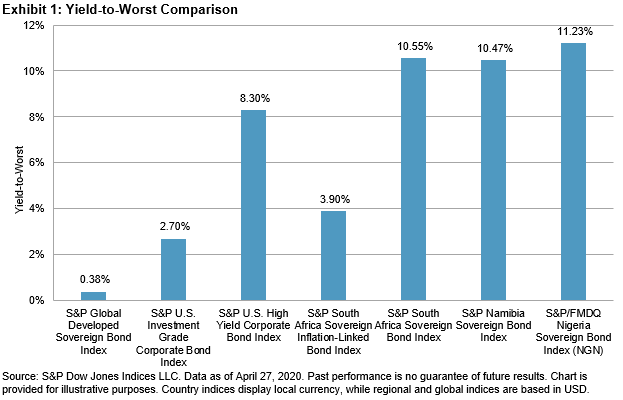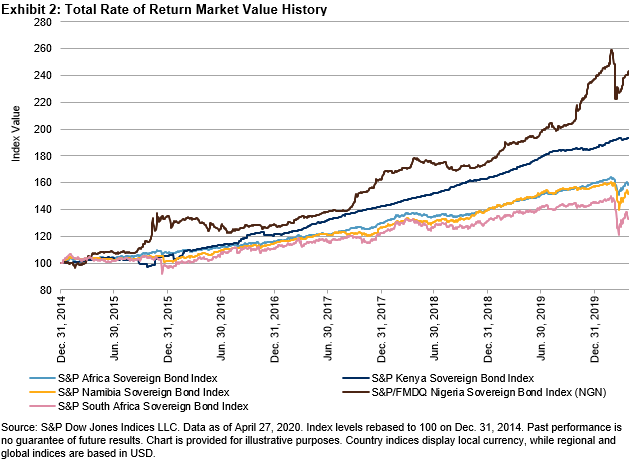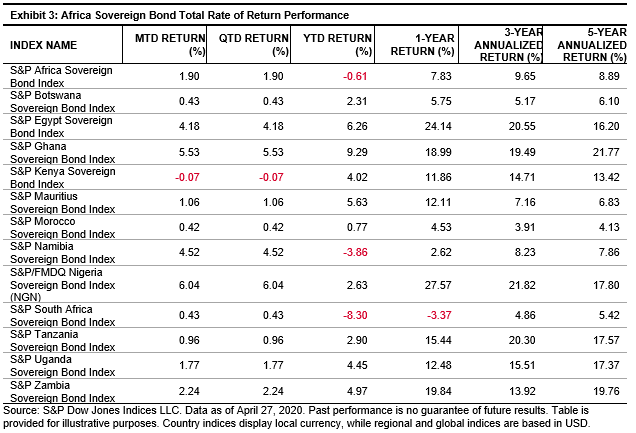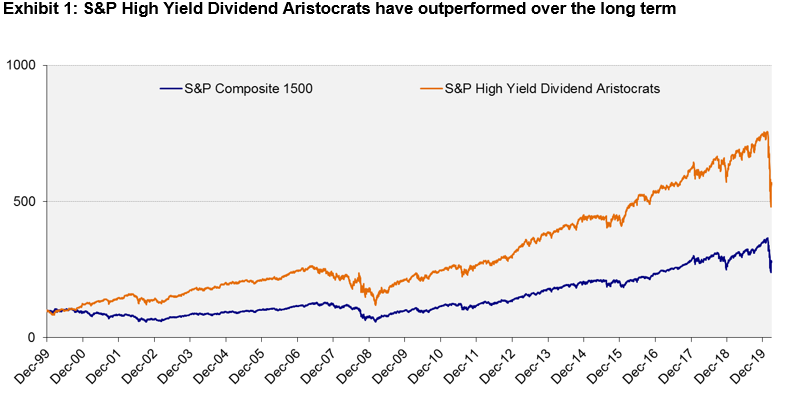How can investors look to reduce financially impactful exposure to transition risk and physical risks whilst gaining exposure to opportunities arising from climate transition? S&P DJI’s Ben Leale-Green explores how our new indices go beyond the scope of the Paris Agreement aligning with a 1.5 degree climate trajectory.
The posts on this blog are opinions, not advice. Please read our Disclaimers.Meet the S&P Paris-Aligned and Climate Transition Indices
Will April Pain Lead to May Gain for Commodities?
ETFs Add to African Access
Durability During Distress
Using Sector & Industry Indices to Uncover Opportunity
Meet the S&P Paris-Aligned and Climate Transition Indices
- Categories ESG
- Tags Ben Leale-Green, climate, climate change, Climate Transition, ESG, indices, Net Zero, PACT, Paris-Aligned
Will April Pain Lead to May Gain for Commodities?

COVID-19 continued to wreak havoc across commodities markets in April. The S&P GSCI fell 9.67% in April and 47.92% YTD. Economic data continued to weaken into uncharted territory. Supply chains crucial to the flow of commodities from extraction to consumption experienced a sudden shut off and demand collapsed. Energy and agriculture underperformed, while metals offered some green shoots.
With the collapse of front-month oil prices on April 20, 2020, the full effect of the oil supply glut was revealed. Market historians can now add negative oil prices to the list of unprecedented market events of 2020. Demand disappearance, diminishing storage capacity, and physically settled May WTI crude oil contracts produced a perfect storm for energy-related commodities. Global energy demand could slump by 6% in 2020 due to the restrictions placed on transport and industrial activity in what would be the largest contraction in absolute terms on record, according to the International Energy Agency. Compounding the hit to price levels that the COVID-19 pandemic has had on demand, oil output from OPEC was the highest since March 2019. OPEC+ production cuts are expected to take effect from the start of May 2020. After falling 54.72% in March 2020, the S&P GSCI Crude Oil dropped another 40.69% in April 2020. Crude oil volatility spiked to all-time highs as the weakness was felt across all oil products.
The S&P GSCI Industrial Metals rose 0.96% in April, reversing some of the downside seen in March. Copper and nickel were both supported by China restarting production facilities that had been on lockdown, as well as supply chain disruptions.
With elevated levels of volatility across assets, the S&P GSCI Gold rose 6.03%, outshining all other commodities and demonstrating its safe-haven status during times of market uncertainty. According to the World Gold Council, investment demand for the yellow metal rose 80% in Q1 2020 compared to the same quarter last year, which offset a 39% fall in jewelry demand.
The S&P GSCI Grains fell 6.25%, with weakness seen across the board. The S&P GSCI Corn underperformed the most (-7.60%) due to its correlation to energy in the ethanol space. The dramatic increase in demand for grocery store food items could not offset the historic lack of demand for ethanol. Cocoa, cotton, and coffee reversed their divergent performance from the prior month. After a strong March, the S&P GSCI Coffee dropped 11.87% in April. After double-digit declines in March, the S&P GSCI Cotton and S&P GSCI Cocoa both advanced 11.56% and 7.12%, respectively.
The S&P GSCI Livestock dropped 5.15% in April. Millions of pounds of meat are expected to be missing from the U.S. supply chain as several major meat producers shut down plants and slaughterhouses. Meat shortages at grocery stores are expected in the near term, as farmers face the likely culling of herds because they will not have anywhere to sell their livestock to be processed. In April, it was estimated that nearly a third of U.S. pork processing capacity was offline.
The posts on this blog are opinions, not advice. Please read our Disclaimers.ETFs Add to African Access

The exchanged-traded fund (ETF) structure has led to increased investment options within fixed income, and the African markets are a clear example of this. Over the past few years, several African ETFs have been introduced to the market, tracking indices provided by S&P Dow Jones Indices in South Africa, Nigeria, and Namibia, giving investors options to participate in this investment space. With transparent indices and tight-knit local ties, S&P Dow Jones Indices and ETF providers have opened asset classes that historically were only accessible to large and more sophisticated investors. Market segments such as high yield, emerging markets, and international markets, which were inaccessible just a few years ago, have become an investment opportunity for all market participants. In addition to accessibility, the yields of African sovereign bonds have tended to be higher than both investment-grade and high-yield corporate bonds in the U.S.

The ETF structure has been around since the early 1990s and has become a popular approach to investing for both equity and debt investments. ETFs are no longer considered a niche product and a growing number of organizations utilize this investment vehicle. The ETF structure has made it easier and cheaper to own and trade big groups of securities at once, on demand. Investors can diversify their exposure by buying entire baskets of securities without buying and selling the underlying individual securities. Because of these efficiencies and benefits, ETFs are being used by investors and traders around the globe.
The popularity of ETFs can be understood by the benefits provided across asset classes. ETFs provide transparency and efficiency as an exchange-traded product that is priced continuously intraday. This makes it easy for an investor to discover the value, gain diversification, and trade in a tactical way. The ETF structure also provides low transaction fees, leading to low management costs, and it can also present tax efficiencies. Recent volatile times have provided a test to ETFs not seen since the global financial crisis of 2008. Nevertheless, ETFs have held their own and have been observed to be an efficient price indicator in challenging markets.
Despite the current economic challenges related to COVID-19, opportunities exist for investment in Africa. Over the past five years, Africa has gone from being a challenge in terms of its financial potential to an enticing prospect for emerging market investors.

A World Economic Forum study mentioned that by 2030, African household consumption is expected to reach USD 2.5 trillion. The study goes on to state: “Nearly half of that $2.5 trillion will be spent in three countries: Nigeria (20%), Egypt (17%), and South Africa (11%). But there will also be lucrative opportunities in Algeria, Angola, Ethiopia, Ghana, Kenya, Morocco, Sudan, and Tunisia. Any one of these countries would be a good bet for companies seeking to enter new markets.”

The African market continues to strengthen its position in the world by developing its economy, manufacturing capabilities, infrastructure, and technology. Additional investments will be required to keep African countries continually growing and achieving future expectations, but the efficiencies of an ETF can assist in making such an investment possible.
The posts on this blog are opinions, not advice. Please read our Disclaimers.Durability During Distress

Income-seeking investors have always had to compromise between the level of dividend payments and the safety of dividend payments. The importance of this tradeoff has recently gone viral, as governmental actions in response to COVID-19 have suppressed global economic activity, causing many companies to suspend or reduce their dividend payments.
Launched in 2005, the S&P High Yield Dividend Aristocrats Index comprises S&P Composite 1500® members that have increased their dividends annually for at least 20 years. The market has rewarded consistent dividend payers: Exhibit 1 shows that the High Yield Aristocrats have outperformed the S&P 1500 over the long term.

As of the beginning of 2020, the aggregate capitalization of the High Yield Aristocrats amounted to 18% of the S&P 1500 Composite. For comparison’s sake, we identified a list of “High Payers” — the 18% of the 1500 Composite with the highest dividend yields. Exhibit 2 compares the median values of these two portfolios on a number of fundamental metrics that measure the strength of companies making dividend payouts.
The High Yield Dividend Aristocrats appear stronger across the board. For example:
- Earnings were double last year’s dividend payouts for the Aristocrats, vs. only 1.2x dividends for the high payers. Cash on hand was also a higher multiple of last year’s dividends.
- The Aristocrats used buybacks to return cash to shareholders to a greater degree than the high payers did. Since buybacks are likely to be reduced before dividends are cut, their usage provides a larger cushion for the Aristocrats.
- The Aristocrats are larger (median capitalization $12 billion) and more profitable (median ROE 15.5%) than their higher-paying counterparts.

There obviously can be no guarantees in a pandemic; if a company’s business is affected badly enough, dividend reductions are always possible regardless of how strong the income statement and balance sheet appeared a year ago. What this analysis tells us, though, is that the dividends of companies with consistent dividend growth are better protected from headwinds.
The posts on this blog are opinions, not advice. Please read our Disclaimers.Using Sector & Industry Indices to Uncover Opportunity
Could higher dispersion in sectors and industries translate to outperformance? S&P DJI’s Anu Ganti explores how index data can be used to inform tactical sector rotation strategies in periods of high volatility.
Get the latest sector dashboard: https://spdji.com/indexology/sectors/us-sector-dashboard.
The posts on this blog are opinions, not advice. Please read our Disclaimers.

